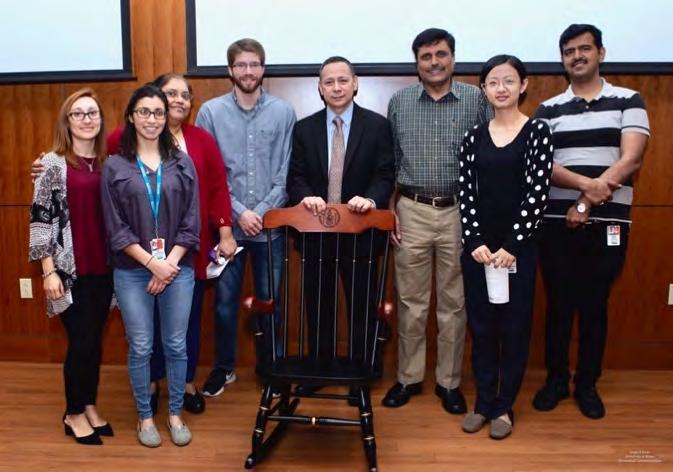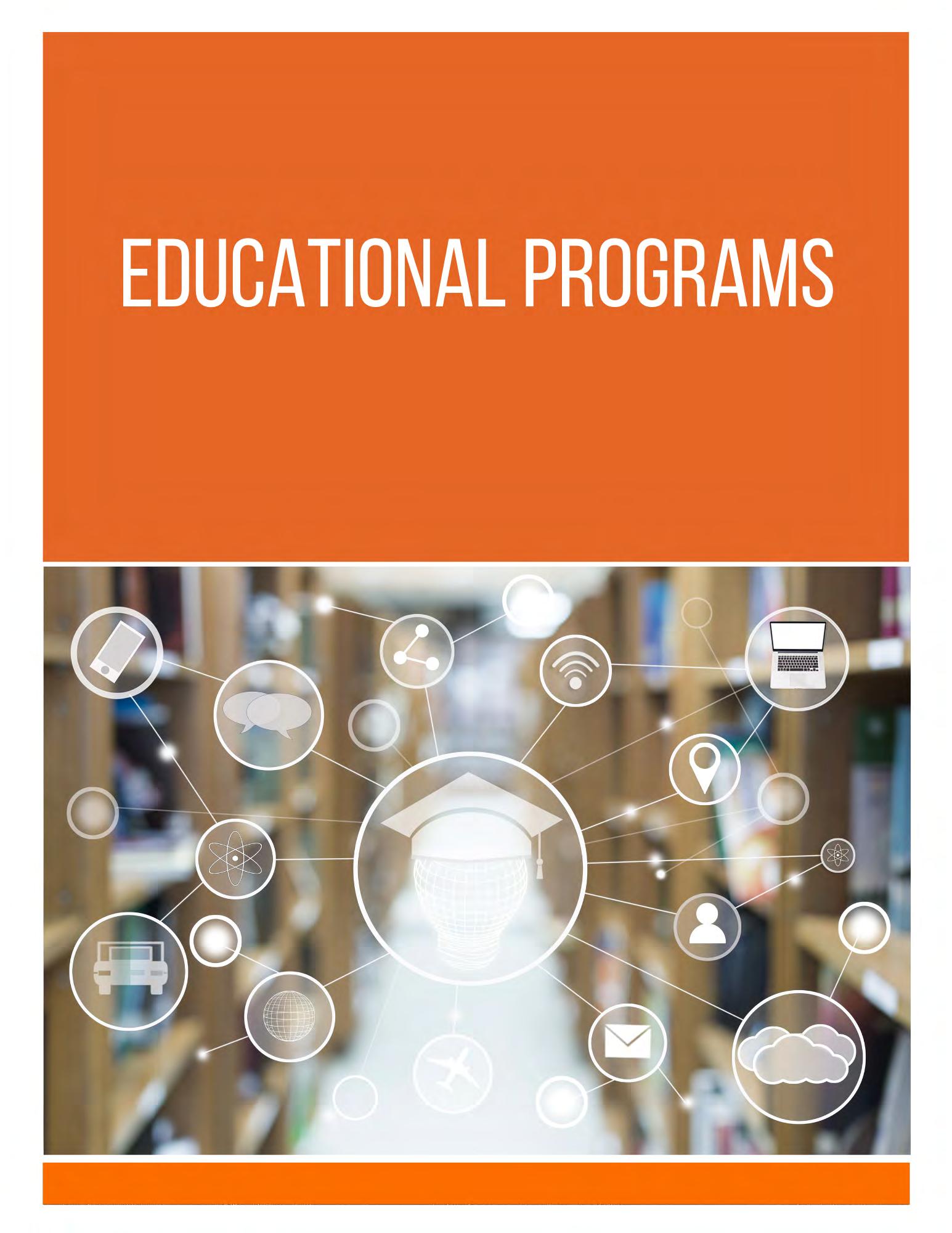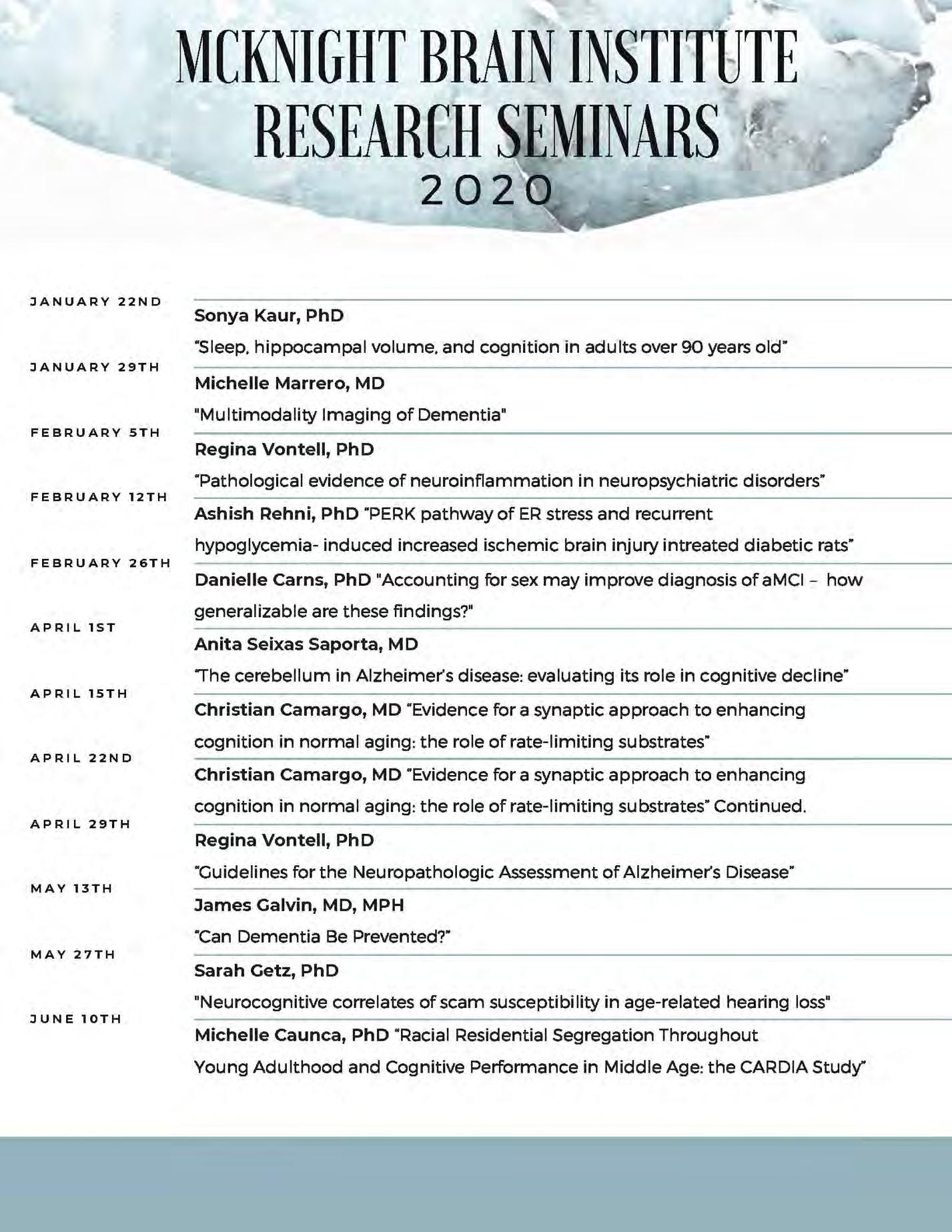
12 minute read
Educational Programs Focusing on Age-Related Memory Loss
appears to be driven by inflammation. They observed elevated levels of sCD14 only in samples that had higher levels of IL-1, suggesting that sCD14 may have a role in the IL-1 inflammatory pathway. Furthermore, preliminary analyses among these 40 cases found that higher values of sCD14 and LPS were associated with greater cognitive decline and higher risk of MCI and dementia. These results are pending publication.
- “The Florida Stroke Registry” led by Dr. Sacco - Funded by state appropriations through the FL Department of Health, the University of Miami, Department of
Neurology, was awarded its fourth round of annual funds for 2019-2020 to manage and maintain the Florida Stroke Registry (the Registry). The Registry now consists of 76% of all stroke centers (~165) in Florida and maintains over 300 stakeholders statewide. Because of its wide reach, the Florida Stroke Registry is well positioned as a platform for communication between stakeholders. During this year centered around the COVID-19 Pandemic, the Registry’s communication platform was refocused and quickly mobilized as an informational resource to its 126 participating
Florida stroke centers needing news on the virus and its relation to their stroke patients. Through the Registry’s various communication modes and access to its multidisciplinary health professional network, the Florida Stroke Registry compiled, documented and developed informational resources specifically related to COVID-19, tackling uncharted clinical territory. Among the multiple Registry media forums utilized during the past year (website, listserv, newsletter, twitter, and webinars), the
“FSR at the Front Lines” is a featured initiative focused on COVID-19, local stroke health care practices, and informal, “boots on-the-ground” information. The initiative consists of short 10min Zoom recorded conversations between 2-3 Registry member clinicians/researchers informally discussing their COVID-19/stroke related experiences, practices, latest findings and ongoing questions. Various topics have been discussed such as (i.e., availability of PPE; protocol for stroke patients diagnosed with COVID-19; the marked drop in stroke admissions shortly after the Pandemic escalated; patients’ reluctance to utilize hospital services due to fears of risks of
COVID-19 transmission; the use of stroke treatments on COVID-19 positive stroke patients, etc.) The videos are archived at the publicly available website. Though viewership and initiative impact have not yet been formally reviewed, an indication of the initiatives value may be derived from the ongoing requests from Registry members to participate in the recordings.
Despite the Pandemic, the Registry continued to develop and establish new relationships among a multidisciplinary group of potential stakeholders. Throughout this past year, the Florida Stroke Registry has not only increased the number of participating stroke centers, but has also facilitated the engagement of non-hospital agencies (i.e., EMS, pharmacy, government, academia, etc.), many of which organized to create regional stroke coalitions. Uniting and attracting the various Florida Stroke Registry stakeholders is the Registry’s ongoing collection of data; to date having collected over 300,000 Florida stroke cases representing years 2010 to current.
Among other research related endeavors, the Registry uses the collected data to provide evidence-based reports. The annual and quarterly reports function as selfmonitoring tools for hospitals to improve performance and the outcomes of their patients, goals that directly and indirectly impact the entire stroke system of care. These powerful performance monitoring tools are actively being used in south and west Florida as the Registry continues to identify and engage local Registry members in the east, north and pan handle Florida regions to lead the initiatives within their respective areas. This year, EMS agencies have approached the Florida Stroke Registry to develop similar tools to address their “pre-hospital” needs, and the Registry has initiated internal discussions to develop reports applicable to a “post-hospital” phase of care. In December of this year, the Registry was approved access to statewide data further enhancing the applicability of Florida Stroke Registry self-monitoring tools and increasing the impact of the Registry at all phases of stroke care. Along with the Registry’s communication initiatives, ongoing self-monitoring reports, research (on quality improvement, clinical treatments for stroke, transitions of care, disparities, etc.), and its growing statewide network, this year’s approval to access state data has squarely positioned the Registry to establish its place as a central axis and resource that impacts the organizational landscape of Florida’s stroke system of care.
“Transitions of Care Stroke Disparity Study (TCSD-S)” (PI: Dr. Sacco) This NIH study aims to identify disparities in transitions of stroke care and key factors associated with effective transitions of care. Programmatically, the study is an example of creativity and persistence as it continues to struggle to accomplish desired enrollment numbers; further impacted this year by the COVID-19 Pandemic and hospital restrictions. Along with multiple online enrollment enhancements including virtual consenting, this year, the study successfully added 5 more study sites. A remaining 3 are pending full onboarding after which a total of 14 statewide stroke centers will be activated as study site collaborators. By the end of 2020, 512 patients were enrolled.
The ongoing Pandemic continues to slow study progress regarding enrollment numbers. Therefore, to successfully proceed with study aims despite the current low study enrollment numbers, he has identified other accessible data sources through the state of Florida. Recently, the application to access data from the Agency for Health Care Administration (AHCA), a large Florida statewide dataset was approved. They are currently organizing the new data set which will become part of an “Inception Cohort” and which will be utilized to develop and validate the proposed Transitions of Care Performance Index. Through the “Inception Cohort” a prediction model for transition of care may be derived which will then be tested on a “Validation Cohort” consisting of the smaller, more detailed, selective, and data-rich TCSD-S enrolled cases. They are enthusiastic to apply the strategy as it supports the project aims to identify disparities in transitions of stroke care, and key factors associated with effective transitions of care after hospital discharge.
Finally, and in parallel to the application of enrollment enhancement efforts, the study team continues to identify patient/caregivers and health care professionals to
nominate to the Intervention Advisory Committee. The committee which is patientcentered, is even more relevant in light of the Pandemic likely new barriers to accomplish successful transition of care from hospital to home. They have recently initiated the involvement of a pharmacy director from one of the participating study sites. Within that hospital system, a unique and successful model of transitions of care that incorporates pharmacist follow-up of stroke patient after discharge. They will continue to seek and engage other health care professionals representing and applying various other models of transition of care (i.e., physical therapists, community paramedics, and community health workers) to develop a wide ranging and experienced committee that will help inform initiatives that may be applied statewide or regionally.
- Dr. Sacco is the Director of The University of Miami Clinical Translational Science
Institute (UM CTSI), a university-wide institute dedicated to accelerating and transforming culturalized clinical and translational science. Created to be an indispensable resource for researchers and stakeholders, the Miami CTSI serves as the
Miami Hub of the national Clinical and Translational Science Award consortium, which works to advance scientific discoveries into improved health care for diverse communities and stakeholders. Together with hub partners that include the entire
University of Miami/University of Miami Health System, Jackson Health System,
Miami VA Healthcare System, OneFlorida Clinical Research Consortium, Health Choice
Network, and Health Council of South Florida, the Miami CTSI focuses on culturalizing health sciences, building and improving clinical and translational research infrastructure and processes, developing the translational research workforce, and community and stakeholder engagement.
Over the past year, the Miami CTSI was highly engaged in the CTSA Consortium, working with nine CTSA institutions across the country on innovative projects, including the development of a lay-friendly clinical research portal and expansion of the I-Corps Entrepreneurship Training Program. In addition, the Miami CTSI supported six mentored career scholars and 16 pilot and collaborative projects. The Miami CTSI also had the opportunity to support three Magic Leap awards to develop augmented/mixed reality biomedical innovations, with one such innovation focused on augmented reality 3D brain imaging to guide neurological surgery. The Miami CTSI also helped amplify minority perspectives in the media by supporting fellows in the Public Voices program, including faculty members in the departments of psychology and neurology. Additional achievements over the past year include holding 130 training events with 1,690 total attendees, enrolling more than 119,000 diverse patients into the Consent to Contact for Research program, completing the first year of the Research Mentoring Training program, and expanding and enhancing informatics support for research, such as URIDE, a de-identified clinical data tool, to house more than 15 million encounters representing 1.26 million unique patients.
The Miami CTSI also responded to the COVID-19 Pandemic, supporting three COVID19 research projects through Emerging Disease Awards. The CTSI worked closely with
institutional partners to enable methods to support virtual clinical research, including HIPAA-compliant Zoom, eConsent training, and eRegulatory Binder. Finally, the Miami CTSI created a website to act as a clearinghouse of all COVID-19 research occurring at the University of Miami, developed COVID-specific university message boards to facilitate collaborations, and launched Translational Tuesdays, a weekly moderated webinar highlighting COVID-19 research advances.
• Dr. Xiaoyan Sun has conducted the following research: - Characterization of the synaptic function in gene levels using post-mortem brains. Using a large-scale transcriptomic dataset, she examined the association of neurogranin (NRGN) gene expression with amyloid and tau pathology in post-mortem brains. She studied the association of NRGN expression with the Clinical Dementia Rating (CDR) and neuropathological diagnosis of AD. She analyzed the NRGNcentered integrative gene network in AD. NRGN expression is correlated with amyloid and tau pathology in the perirhinal cortex of post-mortem brains. NRGN expression is associated with the diagnosis of AD and correlated with CDR. The positively correlated genes with NRGN in AD are involved in synaptic transmission and caution channel pathways. Transcriptional regulation of the genes encoding for synaptic proteins is involved in selective synaptic damage in AD.
- “Systolic blood pressure and cognition in race/ethnic population” - Dr. Sun and colleagues examined the relationship between blood pressure and cognition crosssectionally and longitudinally in the elderly. They found a cross-sectional and longitudinal association of systolic blood pressure (SBP) with cognitive domains. This association was independent of demographics, vascular risk factors, white matter hyperintensity volume and carotid intima-media thickness. The cross-sectional and longitudinal association of SBP with cognition was attenuated or diminished after adjusting anti-hypertension medications in the models. Diastolic blood pressure was not associated with cognition in this cohort.
Basic Science Programs
1. New Programs
• Dr. Perez-Pinzon received a supplemental grant award from the National Institute of
Neurological Disorders and Stroke (NINDS) to conduct studies using a rodent model of vascular cognitive impairment (VCI). In 2021, he and Dr. Dave will establish a rodent model of VCI in the lab.
2. Update on Existing Research
• Drs. Dave and Perez-Pinzon worked on two major projects this year:
- In earlier studies, they observed that exposure to asphyxial cardiac arrest (ACA) induces cognitive impairment in rats and post-ACA physical exercise (PE) preserves cognitive function. Considering the importance of the limbic system in formation and retrieval of long-term memory, in the present study they evaluated the effect of ACA and PE on neuronal survivals in septal and anterior thalamic nuclei regions. Twelve days after ACA, a total of 8 rats (4 exercise and 4 sham) were euthanized for histological analyses. Following cardiac arrest, histopathology revealed significant differences in neuronal survival in both septal and thalamic nuclei in rats that underwent physical exercise post-ACA compared to those that did not exercise. This specifically accounted for a 31% increase in neuronal survival. Moreover, exercised rats also had a higher number of living neurons in the thalamic nuclei than nonexercised control representing a 45% increase of neuronal density. These results demonstrate that physical exercise preserves neuronal survival following asphyxial cardiac arrest in septal and thalamic nuclei. - The second project involves how intensive anti-diabetic therapy aimed at controlling hyperglycemia delays the progression of secondary complications of diabetes.
However, long-term therapy of diabetes increases the risk of patients’ exposure to repetitive transient hypoglycemia. Exposure to recurrent hypoglycemia (RH) is common in diabetic patients receiving glucose-lowering therapies and is implicated in causing cognitive impairments. Increased susceptibility of patients to experience hypoglycemia is due to decreased responses in the hypothalamus: a brain area involved in restoring euglycemia. Therefore, they tested the hypothesis that prior exposure to RH produces metabolic alterations in the hypothalamus. Statistically significant differences were observed in the levels of metabolites of major metabolic pathways. In addition, network analysis showed that prior exposure of ITD rats to RH decreases the levels of metabolites belonging to either amino acid or amine metabolism and pyrimidine/purine metabolism and increases the levels of glycolate.
This study demonstrates that the exposure to RH has a profound effect on metabolism in the hypothalamus. Understanding how RH affects metabolism in the hypothalamus and alters hypothalamic control of blood glucose levels may help in mitigating adverse effects of RH on brain function.
Dr. Perez-Pinzon, Dr. Dave and Team
• Dr. Della-Morte’s research was related to: - The role of Pereoxiredoxin6 on metabolism in aging phenotypes and may further elucidate the understanding of the role these antioxidant molecules have against chronic neurodegenerative diseases.
- COVID-19 showed that COVID patients with lower levels of Plasminogen at hospital are significantly more prone to worse outcomes, including mortality, compared to patients with the normal levels of Plasminogen.
• Dr. Pinto has continued work on several projects that will be finalized in 2021: 1)
Characterization of different phenotypes triggered by complex I or Complex III defects in dopaminergic neurons; 2) Analysis of the role of Mitochondrial Oxidative
Phosphorylation Complex III defects in an Alzheimer's Disease mouse model; and 3)
Mesenchymal Stem Cell treatment of mouse models of frontotemporal dementia.
• Dr. Raval’s research on "Nicotine alters brain oxidative metabolism and exacerbates ischemic brain damage" demonstrated that nicotine in combination with oral contraceptives alters brain energy metabolism, which may be an underlying mechanism(s) of exacerbated ischemic brain injury observed in female rats.
First year medical student Melissa Huberman looking at a histological slide and Jonathan Siegel, Masters in Biomedical Science student pipetting a sample in Dr. Raval’s lab.
• Dr. Vontell worked on the collaborative project with King’s College London, assessing the morphology and pattern of radial glial expression in Trisomy 21 and euploid agedmatched brains. A new finding this year is from mid-gestation, the pattern of expression of radial glia markers had subtle deviations from age-matched euploid fetal brains.
Technology transfer
N/A
Patents/applications
Dr. Della-Morte Submitted a patent application to the University of Rome Tor Vergata entitled “Peroxiredoxin 6 as pharmacological hypoglycemic agent for the treatment of Type 2 Diabetes Mellitus.”
Budget update, status of matching funds, projected budget for coming year
The status of matching funds is not available. The others are in Appendix VI.

Educational Programs Focusing on Age-Related Memory Loss
1. Scientific Education
(MBI) Scientific Education Program Led by Dr. Xiaoyan Sun
This year, MBI in-person meetings and research seminars/discussions were halted in April and began again virtually in May. Meetings were held bi-weekly and were well-attended. Dr. Sun’s scientific educational program consisted of interesting, relevant and novel topics that garnered productive discussion. The scientific presentations are listed below.
McKnight Team Zoom Meeting









